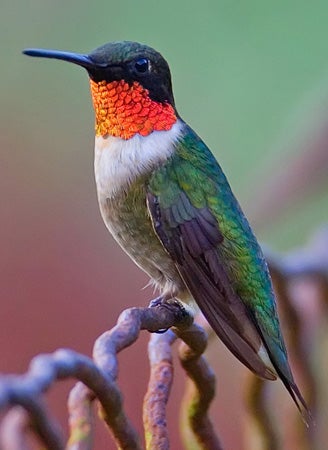SCIENTIFIC NAME:
Archilochus colubris
OTHER NAMES:
Common hummingbird; Ruby Throat
STATUS:
Breeder. Common in spring, summer, and fall, and rare in winter in Gulf Coast regions. In other regions, common in spring, summer, and fall, and occasional in winter. Lowest Conservation Concern.
DESCRIPTION:
Archilochus colubris is 3 to 3 ¾ inches long with a wingspread of 4 to 4 ¾ inches. Both sexes are metallic green above and grayish underneath. Adult males have throat feathers that appear black but flash fiery red or orange in the sunlight. Males have a tail that is slightly forked. Females have white throat patches. Their tails are not forked and have white spots on the outer corners.
DISTRIBUTION:
Ruby-throated hummingbirds nest from Nova Scotia to the Gulf Coast and south Florida, west to Nebraska, Kansas, Oklahoma, and Texas. It winters primarily from south Texas and northeast Mexico south to Costa Rica, Cuba, and Bermuda. It is the most common hummingbird that breeds in the eastern half of North America.
HABITAT:
It inhabits stream sides, open woods, and even gardens where flowering plants can be found.
FEEDING HABITS:
Hummingbirds are strongly attracted to red flowers. They obtain insects and nectar from honeysuckle, petunias, lilies, trumpet creepers, phlox, and sometimes will hover over spider webs and peck out the insects entangled in the web. They are strongly attracted to hummingbird feeders with sugar water. Sugar water can be made easily at home with one part plain white sugar and 4 parts water. In the absence of flowers they depend almost entirely on insects for food.
LIFE HISTORY AND ECOLOGY:
Hummingbirds usually nest along stream sides or in margins of forests about five to 20 feet above ground. Nests are built from ferns, milk weed, young oak leaves, thistles, and are kept in place using spider’s silk or webs from tent caterpillars nests. Females often return to the same place to nest. Eggs are laid from March to July. Nests usually consist of 2 white eggs. The incubation period is 16 days. The young may fly 20 to 22 days after hatching. Hummingbirds may raise two to three broods per season. A Ruby throated hummingbird in flight will beat its wings 55 times a second, up to 61 times a second when backing up, and up to 75 times a second when flying straightaway.
REFERENCES:
Terres, John K., 1991. The Audubon Society Encyclopedia of North American Birds. Wings Books. New York. 546-547 pp.
Peterson, Roger Tory. 1980. A Field Guide to the Birds. Houghton Mifflin Co. Boston. 186 pp.
AUTHOR:
Bennett Moseley, Certified Wildlife Biologist, Division of Wildlife and Freshwater Fisheries






